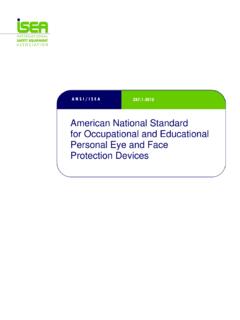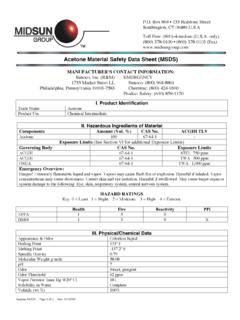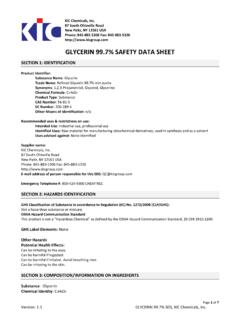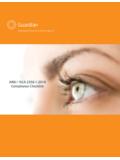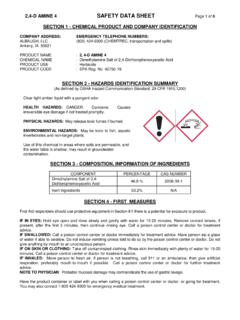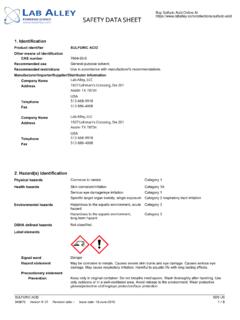Transcription of EMERGENCY EYEWASH & SHOWER EQUIPMENT
1 EMERGENCY EYEWASH & SHOWER EQUIPMENT SELECTION, INSTALLATION & USE GUIDE1 FOREWORD The need for EMERGENCY EYEWASH and SHOWER devices is real. 15,110 workers were afflicted by chemical exposures in 2010, according to the Bureau of Labor Statistics (BLS). 4,580 of these workers experienced chemical exposures to the eyes. According to government data, in 2010 more than 25,000 workers suffered injuries to the eyes. The Occupational safety and Health Administration (OSHA), 29 CFR , requires that: Where the eyes or body of any person may be exposed to injurious corrosive materials, suitable facilities for quick drenching or flushing of the eyes and body shall be provided within the work area for immediate EMERGENCY use. Some States also require EMERGENCY EYEWASH and SHOWER EQUIPMENT in workplaces where there are irritants or chemicals that are toxic by absorption.
2 Many states require the use of ANSI/ISEA compliant EQUIPMENT . The International Plumbing Code (IPC) and the Uniform Plumbing Code (UPC) recognize hazards of caustic and corrosive exposure. IPC, section 411, and UPC, section 416, require the use of ANSI/ISEA compliant EQUIPMENT whenever EYEWASH or SHOWER EQUIPMENT is needed. Department of Energy (DOE) health and safety regulations, found in 10 CFR 851, follow most OSHA regulations. DOE has stated where this [injurious exposure of corrosive materials to the eyes or body] potential exists, there must be an EMERGENCY eye wash facility that meets ANSI standards. The Navy and Air Force also require the use of ANSI/ISEA In addition, an EMERGENCY EYEWASH or SHOWER , placed in the correct location not only minimizes an injury, but the proper selection, placement, maintenance and use of EMERGENCY EYEWASH and SHOWER EQUIPMENT can reduce the cost of workplace injuries.
3 Corrosive Exposures EMERGENCY EYEWASH and showers are part of an employer s worker protection program. Along with safety eyewear, gloves and protective apparel, employers should install EMERGENCY EYEWASH and SHOWER EQUIPMENT . ANSI/ISEA follows established medical opinion that a 15-minute flush of the eyes and body with flushing fluid will provide EMERGENCY first aid mitigation of corrosive or caustic splash exposures. The ANSI/ISEA standard establishes dimensional and performance requirements to ensure that units provide sufficient flow of flushing fluid at a safe temperature and a spray pattern that is sufficient to flush the affected body parts without being injurious. It specifies performance requirements for control valves, so that units operate in 1 second or less and remain in operation until intentionally closed.
4 It requires units that are capable of delivering flushing fluid for 15 minutes. Test procedures and certification requirements are included for performance parameters. In addition, ANSI/ISEA provides performance, installation, maintenance and use information for EQUIPMENT used to minimize injury from harmful chemical exposures to the skin and eyes. ISEA SELECTION, INSTALLATION AND USE GUIDE EMERGENCY EYEWASH AND SHOWER EQUIPMENT 2 Job Hazard Analysis A Key to Compliance A job hazard analysis must be performed to make certain the EQUIPMENT is accessible and operational as prescribed in the ANSI/ISEA standard. A full job hazard analysis will allow you to determine what type(s) of EMERGENCY EYEWASH (es) and/or showers are needed, where and possibly in what quantity. The Hazard Assessment (on pg.)
5 5) contains additional information on selecting the appropriate EQUIPMENT for your facility. The ANSI/ISEA standard provides instructions that units must be properly installed, positioned to deliver flushing fluid in the required pattern and at a safe, tepid temperature, accessible within 10 seconds of a potential exposure, and identified with appropriate signage. Maintenance instructions provide guidance on periodic testing to ensure the proper function of the units; and employee instruction and training is required. These requirements have evolved from years of experience in the design, manufacture and use of EMERGENCY EYEWASH and SHOWER EQUIPMENT , incorporating medical recommendations for timely and continuous irrigation of parts of the body exposed to potentially hazardous materials. Edition No. 1 February 2015 ISEA SELECTION, INSTALLATION AND USE GUIDE EMERGENCY EYEWASH AND SHOWER EQUIPMENT 3 CONTENTS 1.
6 PURPOSE AND SCOPE .. 4 2. DEFINITIONS .. 4 3. HAZARD ASSESSMENT .. 5 4. EQUIPMENT TYPES AND 6 EQUIPMENT Types .. 6 EMERGENCY Showers .. 6 Plumbed EMERGENCY Showers .. 6 Self-contained EMERGENCY Showers .. 6 EYEWASH EQUIPMENT .. 7 Plumbed .. 7 Self-contained .. 7 Faucet Integrated/Mounted Eyewashes .. 8 Eye/Face wash 8 Plumbed Eye/Face Washes .. 8 Self-contained Eye/Face Washes .. 8 Combination SHOWER and EYEWASH or Eye/Face wash Units .. 9 Supplemental EQUIPMENT .. 10 Personal wash Units .. 10 Drench Hoses .. 10 Options/Accessories for Primary EMERGENCY Fixtures .. 11 Alarms .. 11 Backflow Preventers .. 11 Dust Covers .. 11 EYEWASH Test 12 Foot Controls .. 12 Freeze Protection for Self-contained EMERGENCY EYEWASH Units .. 12 Freeze Protection for Plumbed EQUIPMENT .. 13 Modesty Curtains .. 13 Plumbed Hot and Cold Fluid Protection.
7 14 SHOWER Tester .. 14 EQUIPMENT Construction and Corrosive Materials .. 14 5. FLUSHING FLUID ATTRIBUTES .. 15 Flushing Fluid Quality .. 15 Delivery Systems and Temperatures .. 15 Thermostatic Mixing Valves (TMV) .. 16 Tankless Water Heaters .. 16 Heated Storage Tanks .. 16 6. TESTING AND MAINTENANCE .. 17 Weekly Testing .. 17 Annual Inspections .. 17 ANSI/ISEA Annual Inspection Checklist .. 18 7. FREQUENTLY ASKED QUESTIONS ABOUT ANSI/ISEA .. 19 8. ISEA EMERGENCY EYE wash AND SHOWER DIRECTORY .. 21 9. ADDITIONAL INFORMATION .. 22 ISEA SELECTION, INSTALLATION AND USE GUIDE EMERGENCY EYEWASH AND SHOWER EQUIPMENT 4 1. PURPOSE AND SCOPE The purpose of this guide is to provide guidance to users on the need for proper EMERGENCY EYEWASH and SHOWER EQUIPMENT to mitigate injury from splash and ocular incidents, to illustrate EYEWASH and SHOWER EQUIPMENT systems, and to assist in the proper selection, use and maintenance of EMERGENCY EYEWASH and SHOWER EQUIPMENT .
8 NOTE: This document is meant as a guide only and does not replace the current ANSI/ISEA standard. Please review the ANSI/ISEA standard document for specific requirements. 2. DEFINITIONS ANSI/ISEA contains the following definitions: Certified A system whereby a certification organization determines that a manufacturer has demonstrated the ability to produce a product that complies with the requirements of this standard, authorizes the manufacturer to use a label on listed products that comply with the requirements of this standard, and establishes a follow-up program conducted by the certification organization as a check on the methods the manufacturer uses to determine continued compliance of labeled and listed products with the requirements of this standard. Certification organization An independent third party organization that determines product compliance with the requirements of this standard with a labeling/listing/follow-up program.
9 Combination unit An interconnected assembly of EMERGENCY EQUIPMENT supplied by a single source of flushing fluid. Drench hose A supplemental device consisting of a flexible hose connected to a flushing fluid supply and used to provide fluid to irrigate and flush face and body areas. EMERGENCY SHOWER A device specifically designed and intended to deliver flushing fluid in sufficient volume to cause that fluid to cascade over the entire body. Eye/face wash A device used to provide fluid to irrigate and flush both the face and the eyes simultaneously. EYEWASH A device used to provide fluid to irrigate and flush the eyes. Flow pressure The pressure in the water supply pipe near the water outlet while the faucet or outlet is fully open and flowing. Flushing fluid Potable water, preserved water, preserved buffered saline solution or other medically acceptable solution manufactured and labeled in accordance with applicable government regulations.
10 Freeze protected EQUIPMENT EQUIPMENT designed to allow the EMERGENCY device to operate under freezing conditions. Freeze protection A means to protect flushing fluid in an apparatus from freezing and rendering it inoperable. This can be achieved through several means including mechanical valves and electrical heat tracing. Hazardous material Any substance or compound that has the capability of producing adverse effects on the health and safety of humans. ISEA SELECTION, INSTALLATION AND USE GUIDE EMERGENCY EYEWASH AND SHOWER EQUIPMENT 5 Personal wash A supplementary device that supports plumbed and/or self-contained units, by delivering immediate flushing fluid to the eyes or body. These devices do not meet all of the ANSI/ISEA standard s requirements, such as providing a 15-minute flush/drench and flushing both eyes simultaneously.
